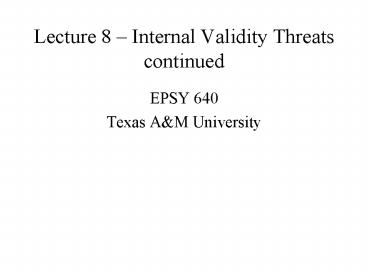Lecture 8
1 / 15
Title:
Lecture 8
Description:
PRETESTING OR REPEATED TESTING. proactive or retroactive interference. memory ... conditions at the time showed that a series of blizzards at the time severely ... – PowerPoint PPT presentation
Number of Views:26
Avg rating:3.0/5.0
Title: Lecture 8
1
Lecture 8 Internal Validity Threats continued
- EPSY 640
- Texas AM University
2
TESTING
- PRETESTING OR REPEATED TESTING
- proactive or retroactive interference
- memory
- change in cognitive schema or structure
3
TESTING
- SOLOMON 4 GROUP DESIGN
1 R O X O 2 R O O 3 R X O 4 R O
4
TESTING
- Willson and Putnam (1982) conducted a
meta-analysis of studies using pretests and
concluded that pretesting can effect both
cognitive and psychological testing. The largest
effects can be expected to occur within about two
weeks of pretesting, and effects on achievement
and intelligence tests is expected to be greater
than effects for attitude or psychological tests.
5
MORTALITY
- LOSS OF CASES FROM GROUPS NONRANDOMLY
- POTENTIAL FOR PARTICULAR CONDITION TO CAUSE
DROPOUTS - NEED FOR INITIAL INFORMATION ON ALL PARTICIPANTS
TO EXAMINE CHARACTERISTICS OF DROPOUTS
6
REGRESSION TOWARD MEAN
- EQUIVALENT TO IMPERFECT CORRELATION BETWEEN
VARIABLES - EXISTS WHENEVER A SAMPLE IS SELECTED AND ITS MEAN
IS NOT EQUAL TO THE POPULATION MEAN, THEN
MEASURED ON ANOTHER VARIABLE
7
REGRESSION TOWARD MEAN
- REGRESSION OCCURS WITH
- GIFTED AND TALENTED RESEARCH
- RESEARCH IN SPECIAL EDUCATION
- RESEARCH ON ANY NONREPRESENTATIVE GROUPS
8
REGRESSION TOWARD MEAN AND MATCHING
- MATCHING ALWAYS PRODUCES REGRESSION EFFECTS
UNLESS THE TWO SAMPLES MATCHED HAVE THE SAME
POPULATION MEANS
9
REGRESSION TOWARD MEAN AND MATCHING
- In a study of a new intelligence test researchers
gave the test to students who had been previously
evaluated with another intelligence test and
found to have scored over 120, qualifying them
for gifted and talented status. The researchers
found that the students averaged below 120 on the
new test and concluded that the new test did not
adequately assess gifted and talented status.
What they actually found was the regression
effect due to the lack of perfect correlation
between the two intelligence tests. A simple
calculation from their reported results conformed
quite well to the expected lowering of score from
one assessment to the other.
10
Statistical regression due to matching
group 1 group 2
matching mean for selecting variable
Outcome correlates .7 with selecting
variable Group 1 predicted score on outcome
.7SD Group 2 predicted score on outcome .35
SD Thus, .35SD difference has been created with
no treatment
1SD
½ SD
11
HISTORY
- CHANGES AND EVENTS OUTSIDE TREATMENT CONDITIONS
THAT AFFECT OUTCOMES - Local or national events of stress
- Weather
- Political change
12
HISTORY
- Campbell and Ross (1968) and Glass (1968)
evaluated the effect of a speed limit law in
Connecticut enacted to begin in January, 1955.
Politicians claimed within several months that
the law had reduced significantly auto deaths,
using data from the previous several years to
support their claim. Indeed, statistical analysis
supported a significant drop in deaths in the
months following the implementation of the law,
even accounting for typical drops occurring after
the Christmas season. Glass (1968) noted that an
analysis of the surrounding states showed a
similar drop even though no laws had been enacted
in them. An investigation of weather conditions
at the time showed that a series of blizzards at
the time severely restricted driving,
particularly high speed driving that would have
contributed otherwise to auto deaths. He and
Campbell and Ross (1968) discounted the legal
experimental account in favor of the historical
explanation. Willson (1973), reported in Glass,
Willson, and Gottman (1975) demonstrated that the
legal effect was not significant when adjusted
for the comparable effects in other adjacent
states
13
(No Transcript)
14
(No Transcript)
15
(No Transcript)































